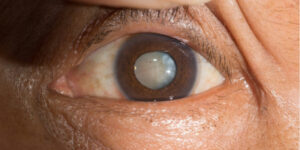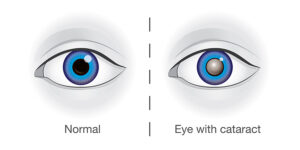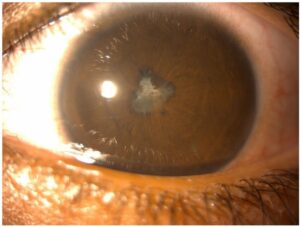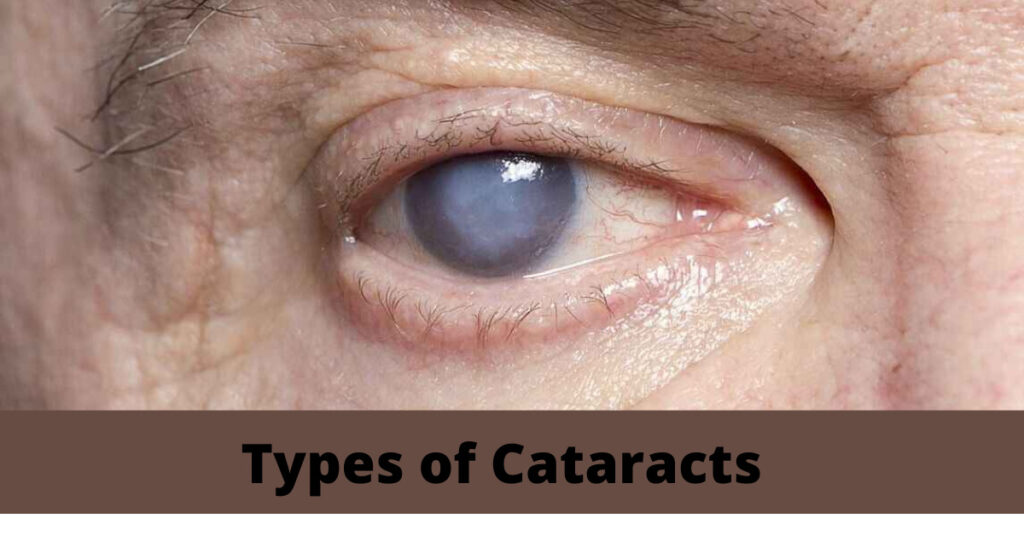Cataracts are a common eye problem that can occur in both adults and children. Cataracts are the leading cause of blindness worldwide. There are several different types of cataracts, all of which have different causes and symptoms. In this blog post, we will discuss the most common types of cataracts. Additionally, we’ll explore their unique symptoms, what leads to their development, and importantly, the treatment options available for each. Plus, we’ll share some effective prevention tips to help protect your vision. So, join us as we shed light on these different forms of cataracts and empower you with knowledge for better eye health.”
What Is a Cataract?
 A cataract is a clouding of the eye’s natural lens. The lens is responsible for focusing light onto the retina, which is the back surface of the eye where images are formed. When a cataract develops, images become blurred.
A cataract is a clouding of the eye’s natural lens. The lens is responsible for focusing light onto the retina, which is the back surface of the eye where images are formed. When a cataract develops, images become blurred.
A cataract occurs when proteins in the eye’s lens clump together and block or scatter light. Cataracts typically develop slowly and can affect one or both eyes. They are very common in older adults. By age 80, more than half of all Americans either have a cataract or have had surgery to remove one.
Most cataracts form gradually and don’t disturb your vision early on. An early sign may be a need for more light when you read or do close-up work. You may have trouble seeing at night.
You may notice that colors seem faded and that glare from headlights, lamps, or the sun bothers you more than it used to. A cataract usually affects both eyes, but generally, only one eye is affected at a time.
Cataracts are treated with surgery to remove the cloudy lens and replace it with an artificial lens. More than 90 percent of people who have cataract surgery experience improved vision afterward. Surgery is usually performed on an outpatient basis, which means you can go home the same day.
Different Types of Cataracts
Cataracts, a leading cause of impaired vision, can manifest in several forms, each with unique characteristics and origins. Understanding the different types of cataracts is key to recognizing their symptoms and seeking appropriate treatment. Here are the common types:
Age-Related Cataract
These are cataracts that typically develop as a part of the natural aging process. Over time, the lens of the eye becomes less transparent, leading to the formation of cataracts. Age-related cataracts are the most common type and are primarily associated with the aging of the eye.
Pediatric Cataract
Pediatric cataracts refer to those that occur in infants or children. These can be congenital, meaning present at birth, or can develop during childhood. Unlike age-related cataracts, pediatric cataracts are not due to aging but are often linked to genetic factors, developmental issues, or other health conditions.
Nuclear Sclerotic
Nuclear sclerotic cataracts are the most common type of cataracts, and they tend to form gradually as we age. This type of cataract affects the center of the lens, making it appear yellow or brown. Nuclear sclerotic cataracts can cause blurry vision and make it difficult to see at night. In this type of cataract, the pupil may also appear larger than normal. Nuclear sclerotic cataracts are treated with surgery.
Cortical
Cortical cataracts form at the edges of the lens and can cause the appearance of spokes radiating from the center of your vision. This type of cataract can make it difficult to see objects clearly and can cause glare. Cortical cataracts are treated with surgery. This type of cataract is more common in diabetics. Cortical cataracts are also more common in people who have had previous eye injuries or inflammation.
Posterior Subcapsular
Posterior subcapsular cataracts form on the back surface of the lens and can cause symptoms such as glare and difficulty seeing at night. This type of cataract is more common in people with diabetes, high myopia, or those who take certain medications such as steroids. Posterior subcapsular cataracts are treated with surgery.
Congenital
Congenital cataracts are present at birth or develop in early childhood. These cataracts can be caused by infection during pregnancy, genetic disorders, or trauma to the eye during childbirth. Congenital cataracts are treated with surgery.
Traumatic
Traumatic cataracts can develop after an injury to the eye. These cataracts can be caused by a blow to the head, penetrating eye injury, or radiation exposure. Traumatic cataracts are treated with surgery. In this type of cataract, the pupil may also appear larger than normal.
Subcapsular
Subcapsular cataracts form under the lens capsule, which is the clear outer covering of the lens. This type of cataract can cause vision to become blurred and make it difficult to see at night. People with diabetes or those taking high doses of steroids are at a higher risk for developing this type of cataract. Subcapsular cataracts are treated with surgery.
How Are These Cataracts Diagnosed?
 A comprehensive dilated eye exam is the best way for your doctor to check for cataracts and other vision problems. In this exam, your doctor will use a special magnifying lens to examine your retina and optic nerve for signs of damage and other eye problems. Your pupils will be dilated so that your doctor can better assess the health of your internal eye structures. After the examination, you may experience blurry vision for a few hours as your pupils return to their normal size.
A comprehensive dilated eye exam is the best way for your doctor to check for cataracts and other vision problems. In this exam, your doctor will use a special magnifying lens to examine your retina and optic nerve for signs of damage and other eye problems. Your pupils will be dilated so that your doctor can better assess the health of your internal eye structures. After the examination, you may experience blurry vision for a few hours as your pupils return to their normal size.
Doctors may evaluate the severity of cataracts using the following scale:
- Grade I: Small, not causing vision problems
- Grade II: Moderate, causing mild vision problems
- Grade III: Large, causing significant vision problems
- Grade IV: Severe, interfering with daily activities such as reading or driving.
If your doctor suspects you have a cataract, they may recommend additional testing, such as:
- A Visual Acuity test: This measures how well you see at various distances.
- A Tonometry test: This measures the pressure inside your eye.
- An Autorefraction or Retinoscopy: These tests help determine your eyeglass prescription.
- Pupil Dilation and Fundus Photography: These tests provide detailed images of the inside of your eye.
Your doctor will also ask about your medical history and any medications you’re taking, as some can increase your risk of developing cataracts. There can also be other causes of your symptoms, such as refractive errors or age-related macular degeneration. Therefore, it’s important to have a comprehensive eye examination to rule out other conditions.
Signs
 There are many common signs of types of cataracts. Some of these common signs are:
There are many common signs of types of cataracts. Some of these common signs are:
- A Cloudy or Fuzzy Appearance To Your Vision
This happens because the cataract has begun to block some of the light that would normally enter your eye. This can make it difficult for you to see clearly, especially when looking at objects far away. - Change in the Color of your Eyesight
If you have cataracts, you may also notice a change in the color of your eyesight.
For example, if you have a blue cataract, objects may appear yellowish-brown instead of their true color. It also may become more difficult for you to tell the difference between similar colors, such as blue and purple. - Poor Night Vision
This happens because the cataract makes it more difficult for your eye to adjust to changes in light. As a result, you may have trouble seeing clearly when it’s darker outside or when you’re driving at night. Sometimes there maybe. You may also notice that you’re more sensitive to glare from oncoming headlights. - Glare and Halos Around Lights
This can happen when the cataract blocks some of the light that enters your eye, which can be especially bothersome when you’re driving at night. - Frequent changes in your eyeglass or contact lens prescription
This is because the cataract can cause your eye to change shape, which affects how light enters your eye and how well you see. - Eye Pain or Redness
- Constant headache
This happens because the cataract can cause your eyes to work harder to see, which can lead to strain and headaches.
These are just some of the signs that you may have a cataract. If you notice any changes in your vision, it’s important to see an eye doctor for a comprehensive exam.
Causes
 There are many different causes of the different types of cataracts.
There are many different causes of the different types of cataracts.
- Age
As people get older, the protein fibers in the lens start to break down and clump together. This makes the lens thicker and less flexible, which eventually leads to clouding. - Genetics
This means that if your parents or grandparents had cataracts, you’re more likely to develop them as well. Also, genetics is one of the causes of different types of cataracts.
For example, people with Down syndrome are more likely to develop a cataract in their twenties or thirties. Those with other genetic conditions, such as Marfan syndrome or Stickler syndrome, may also be at increased risk. - Medical Conditions
Several medical conditions such as diabetes, high blood pressure, and arthritis can increase your risk of developing cataracts. - Trauma
In some cases, trauma to the eye can cause a cataract. This includes both physical trauma, such as a blow to the head, and chemical trauma, such as being hit in the eye with a strong acid. - Certain medications
Certain medications can also increase your risk of developing cataracts. These include steroids, antipsychotic drugs, and certain antibiotics.
Prolonged exposure to ultraviolet (UV) light can also damage the lens and lead to cataracts. This is why it’s important to wear sunglasses that block UV rays when you’re outdoors. - Diabetes
Diabetes can damage the blood vessels in the lens, which leads to clouding. People with diabetes are also more likely to develop cataracts at a younger age than those without diabetes. - Smoking
Smoking is another important cause of cataracts. Studies have shown that smokers are two to three times more likely to develop cataracts than nonsmokers.
Prevention & Treatment Methods
Treating cataracts depends on the severity of your vision loss and how much it’s impacting your daily life. In some cases, glasses or contact lenses may help improve your vision. If cataracts are causing more significant vision problems, you may need surgery to remove the cloudy lens and replace it with an artificial one.
Here’s an overview of how to potentially prevent and treat different types of cataracts:
Prevention Strategies
- Regular Eye Exams: Routine check-ups can help detect cataracts and other eye problems early.
- UV Protection: Wearing sunglasses that block UV rays can protect your eyes from sun damage that could lead to cataracts.
- Healthy Lifestyle: A diet rich in vitamins and antioxidants, regular exercise, and avoiding smoking can lower the risk of developing cataracts.
- Manage Health Conditions: Proper management of health issues like diabetes is crucial as they can increase cataract risk.
Treatment Methods

- Cataract Surgery
There are two main types of surgery for cataracts: traditional cataract surgery and laser-assisted cataract surgery. During traditional cataract surgery, your surgeon will make a small incision in your eye and manually remove the cloudy lens. With laser-assisted surgery, a computer is used to guide a laser beam to make the incisions in the eye. This type of surgery is often used for people who have hard-to-treat cataracts. - Intraocular Lens Implants
After your cloudy lens is removed during cataract surgery, it will be replaced with an artificial intraocular lens (IOL). Accommodating IOLs are designed to work like your natural lens, giving you the ability to focus on objects at all distances. - Eye-Drops
One of the most common treatments for cataracts is the use of eye drops. These drops help to lubricate the eye and prevent the formation of new cataracts. - Contact Lenses
Another treatment options are contact lenses. There are two types of contact lenses: hard and soft. They allow oxygen to reach the cornea, which is important for eye health.
Conclusion
Cataracts are a common cause of vision loss, but with early diagnosis and treatment, many people can maintain good vision. There are different types of cataracts, each with its own set of symptoms and treatment options. If you think you or a loved one may have a cataract, be sure to see an eye doctor for a comprehensive exam. With proper care, you can keep your vision clear for years to come.
Cataract surgery is a safe and painless procedure. At EyeMantra we have a team of experienced eye surgeons, who will be happy to answer your any questions on cataract surgery, cataract surgery cost, cataract lens cost for different cataract surgery types- Phacoemulsification, MICS & Femto Laser Cataract. Call us at +91-9711116605 or email at [email protected] for inquiries.


